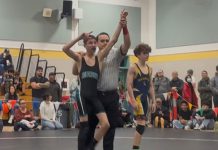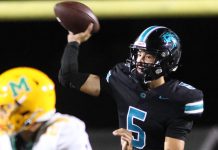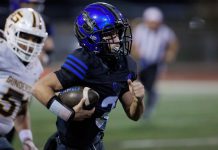If we learned anything on the Sports Panel at Gilroy High’s
Career Night on Thursday, it’s that careers in sports have a lot
less to do with actual sports than people think.
If we learned anything on the Sports Panel at Gilroy High’s Career Night on Thursday, it’s that careers in sports have a lot less to do with actual sports than people think.
Also, that speaking for five minutes straight without rambling at the end is nearly impossible.
Well, for me anyway. My co-panelists, personal trainer Kelly Ramirez and Gavilan athletic director Ron Hannon did just fine in the glare of the spotlight.
Kelly taught at Gilroy High and Gavilan for 15 years. Somewhere along the way she got the running jones, and it stuck. She’s run two Boston Marathons and was part of the winning team of five women from Gilroy who took first in the relay event at last Sunday’s Big Sur International Marathon.
As a personal trainer, she’s her own boss. Kelly related to two groups of students on Career Night how her job consists of not just training clients, but also of promoting her services, managing the finances of her business, coordinating schedules and chasing down money owed to her.
If you’re counting at home, that’s roughly one part sports and four parts regular working stiff stuff.
Ron was a standout basketball player at Gilroy High and Gavilan. He realized his lifelong dream of playing Division I ball – for San Jose State. But he played it smart off the court while he was excelling on it. He got his Master’s in kinesiology with an eye towards a career in sports administration.
Now he’s the Dean of Physical Education and Athletics at Gavilan. Yes, he explained to the students, he gets to go to a lot of ballgames. But he also administers an entire department at the college, manages various subordinates and is responsible for an entire athletic budget.
Sports plays a relatively small part in his day-to-day activities.
When I finished my own disjointed presentation to the workshop, a young woman in the front row asked me, “Do you get to go to games for free?”
I was tempted to say, “Hey, I get paid to go to them …”
But I resisted.
Instead, I tried to convey the idea that sports journalism really is work. With deadlines an ever-looming threat, you find yourself rooting for a quick knockout at the fights you cover, 1-2-3 innings at baseball games and anything – anything – but overtime.
Yes, part of the sports fan in you dies when you work in sports.
But not all of it.
For as much as non-sports business is a part of their working lives, Kelly and Ron still say the greatest reward they receive from their jobs is a sports reward. Seeing athletes, young and old, achieve their goals. Helping someone to become physically fit at an age when perhaps they thought it might be too late. Offering all the resources of Gavilan to assist a student-athlete to leave it all on the field, while finding a purpose off it.
The time we had with the students Thursday night was brief. It’s tough to tell how much of our attempts to relate our experiences sunk in. Perhaps someday, when one of those kids is working in the sports industry in some capacity, they’ll remember a thing or two we said.
Maybe they’ll think, boy, this job isn’t all hot dogs and high fives.
No it isn’t. But you know something – and I’ll bet Kelly and Ron and our theoretical future colleague would agree – it’s the only job we’d ever want.














